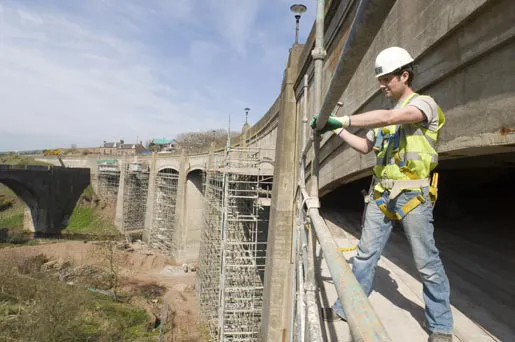In the first article of a three-part series on preventive maintenance, Alan S. Kercher, of Kercher Engineering, highlights the value to road agencies of a properly implemented pavement preservation programme For many road agencies, the budget for maintenance, rehabilitation and reconstruction (MR&R) of their roads is focused mainly on the pavements that are in the worst condition.
In the short term, this common approach may seem very logical. However, when focused on expensive structural improvements,
February 14, 2012
Read time: 7 mins

In the first article of a three-part series on preventive maintenance, Alan S. Kercher, of Kercher Engineering, highlights the value to road agencies of a properly implemented pavement preservation programme
For many road agencies, the budget for maintenance, rehabilitation and reconstruction (MR&R) of their roads is focused mainly on the pavements that are in the worst condition.In the short term, this common approach may seem very logical. However, when focused on expensive structural improvements, an agency can only afford to repair a very small percentage of its pavements. This is because the cost of repairs increases exponentially as the amount of deterioration increases. For example, one kilometre of pavement can cost US$100,000 or more to repave with a functional overlay. If excessive deterioration is allowed to occur and reconstruction is necessary, the cost of rebuilding one kilometre of road could easily reach US$300,000 or more.
Repairing a few pavements, while allowing the majority of pavements to continue deteriorating, is a very short-sighted management approach. As shown in Figure 1 below, delaying needed maintenance can turn out to be a very expensive budgetary strategy. However, a properly implemented pavement preservation programme, utilising preservation treatments, will allow agencies to cost-effectively extend the life of many pavements. Additionally, this will result in improved ride quality and skid resistance, as well as reduced user delays and user costs.
SIMPLE PHILOSOPHY
Pavement preservation programmes should be founded on the simple philosophy: keep the "good" roads in good condition, fund emergency repairs as necessary and develop a long-term capital improvement fund for reconstruction of the streets in poor condition. Since the cost of reconstructing roads is extremely onerous, it is much more cost-effective to intervene in the early stages of pavement deterioration. The goal is to maximise the taxpayer's investment in the infrastructure by extending its life. This is accomplished by utilising a variety of properly timed treatments that fall into the following three repair strategies.Routine maintenance: consists of minor reactive maintenance activities; including crack sealing and pothole patching intended to repair localised defects before more costly repairs are required.
Preventive maintenance: consists of planned activities to extend pavement life for pavements in good condition. Surface treatments are applied globally to a pavement to seal the surface. This will prevent water infiltration, slow down oxidation and aging and stabilise loose surface materials.
Functional rehabilitation: consists of planned activities to extend pavement life for pavements in fair condition. Typical candidates for this type of repair have more environmental cracking (low temperature shrinkage cracks) and weathering (oxidation and ravelling) than pavements that fall into the preventive maintenance category. As such, thin overlays will be more cost-effective than surface treatments.
PROPER TIMING
The surface of a pavement is a very good indicator of when preservation treatments should be applied. The two prime indicators that the asphalt cement is aging are environmental cracks and weathering. For example, the best time to apply a preventive maintenance treatment is when transverse cracks first start to show up and/or when the surface starts to oxidise and ravel (pitting of the surface). This is because very little distress has occurred, which means that the pavement still retains much of its elasticity and should still be able to perform well for many years. Also, if the pavement is in good condition, there will be little or no prep work such as crack sealing and patching, which can be costly.However, if the pavement is allowed to deteriorate significantly, there will be little remaining life left in the pavement. In this case, the preservation treatments would provide much less benefit.
INTEGRATE WITH PAVEMENT MANAGEMENT
Although "the right treatment, at the right place, at the right time" may sound simple, it can be a very difficult task to accomplish. There are many factors that affect how an agency manages its MR&R programme. Road agencies should integrate pavement preservation into their pavement management procedures, utilising an advanced pavement management system. This will allow an agency to develop an optimised long-term work plan that will provide the most cost-effective combination of pavement preservation and structural improvement projects to meet the agency's objectives.2010 GRAA Winner Profiles
Our series of winning projects from the 2010 Global Road Achievement (GRAA) Awards continues with a landmark operations and maintenance programme conducted in Afghanistan
From 2002-2007 donors from around the world rehabilitated thousands of kilometres of roads in Afghanistan.Now the country faced a challenge: maintaining the upgraded roads.
After years of internal conflict, many professionals had fled the country and the Government of the Islamic Republic of Afghanistan (GIRoA) lacked the capacity necessary to meet the level of maintenance services required.
Routine maintenance can be a difficult task, often involving several management parties who must work together. Add a war-torn country to the mix and one might simply relegate the goal of efficient and proper maintenance of roads to the realm of forgotten ideals.
But The Louis Berger Group (LBG) and the US Agency for International Development (USAID), together with the Ministry of Public Works (MPW) of the GIRoA, set out to perform maintenance and repairs, and implement institutional reform and capacity building. The monumental nature of the accomplishment is highlighted by Eric Cook, senior engineer at LBG.
"[This Project] in Afghanistan will go down in history as a major project.
The scale of the works is in the league of the Brooklyn Bridge; Panama Canal and the Suez Canal." Today, LBG manages a national roads operation and maintenance (O&M) and capacity building programme to ensure the sustainability of these roads for the people of Afghanistan as a Task Order (TO-14) under USAID's Afghanistan Infrastructure and Rehabilitation Program (IRP). USAID and LBG are working towards turning over all O&M to an MPW aligned with first world management systems.
LBG's Afghan subcontractors perform all routine maintenance and emergency repair work under its supervision, and is working to build their technical and managerial capacity within both the contractor base and MPW.
The programme breaks the highway system down into maintenance packages, dividing responsibility for maintaining a level of service along the roadways. Each Afghan subcontractor is responsible for managing routine maintenance activities associated with the roadwayrelated assets. These assets include drainage, slopes, bridges, causeways and pavement surfaces.
LBG has instituted performancebased management of these assets, which requires subcontractors to maintain a pre-established level of service, as specified in the subcontract, and execute maintenance and repairs within a predetermined time frame to receive their full payment. LBG's staff monitors all road conditions to ensure maintenance and repairs are performed as required and to certify the subcontractors' monthly invoices. However, this model also allows for the flexibility that is necessary in such a complex environment; the subcontractor determines the amount and location of work necessary to meet the required level of service.
The emergency repair programme is also critical to success. Although the subcontractors repair assets damaged by natural forces such as flooding and mudslides, they also respond to damage caused by insurgent destruction along the roadways and bridges. Emergency and unscheduled works are paid according to prenegotiated unit costs.
In June 2010, the programme held a conference in New Delhi, India, for high-ranking officials from the public and private sectors. At the conclusion, they agreed to establish a National Roads Authority with a dedicated and transparent stream of funding. This will ensure sustainability and institutional reform using performance contracting in the private sector, and ultimately reduce dependence on donor funding.
"This programme has strengthened the capacity of the MPW to manage road maintenance tasks, leading to the creation of a national highway authority, and provided economic benefits though the development of the private sector," said LGB's president, Larry Walker.
The programme has been so successful in the first 3 years, that the Asian Development Bank will continue funding the maintenance while USAID has agreed to fund further management efforts. This project has been referred to in presentations by a USAID official as the best TO in the IRP.
Some of the work is being performed on primary and secondary roads that include the Kabul to Kandahar highway, which is among the most dangerous roads in the world.







